Discover the gentle art of somatic yoga, a practice focused on internal sensations and mind-body connection․ Ideal for beginners, it offers a therapeutic approach to release tension, ease stress, and promote emotional well-being through slow, intentional movements․
What is Somatic Yoga?
Somatic yoga is a gentle, therapeutic practice that combines traditional yoga with somatic movement therapy․ It focuses on internal sensations, encouraging mindful movement to enhance mind-body connection․ By prioritizing awareness of bodily sensations, somatic yoga helps release tension, improve flexibility, and promote relaxation․ This approach is particularly beneficial for beginners, as it emphasizes slow, intentional movements and breath awareness, making it accessible to all․ It offers a holistic way to address physical and emotional well-being, fostering a deeper understanding of the body and its needs․
How Somatic Yoga Differs from Traditional Yoga
Somatic yoga differs from traditional yoga by focusing on internal sensations rather than external alignment or achieving specific postures․ It emphasizes slow, mindful movements to re-educate the brain and release chronic tension․ Unlike traditional yoga, which may prioritize physical postures and flow, somatic yoga is more therapeutic, encouraging a deeper connection with the body’s inner wisdom․ This approach makes it highly accessible, especially for those with limited mobility or chronic pain, offering a gentle path to healing and relaxation․ The practice is less about perfection and more about awareness and release․
Benefits of Somatic Yoga for Beginners
Somatic yoga offers a gentle approach to release muscle tension, improve flexibility, and manage stress․ It enhances posture, body awareness, and emotional well-being, making it ideal for all levels․

Releasing Muscle Tension and Improving Flexibility
Somatic yoga gently targets chronic muscle tension, promoting relaxation and mobility․ By focusing on internal sensations, slow stretches, and therapeutic movements, it helps release tightness without strain․ This practice enhances flexibility by re-educating the nervous system, allowing muscles to lengthen naturally․ Regular practice reduces physical discomfort, improves range of motion, and fosters a deeper connection between body and mind, leading to long-term relaxation and ease․
Managing Stress and Anxiety
Somatic yoga offers a powerful way to calm the mind and soothe the nervous system, reducing stress and anxiety․ Gentle, slow movements and mindful breathing help release physical tension stored in the body․ By fostering awareness of internal sensations, this practice encourages relaxation and emotional balance․ It creates a safe space to unwind, allowing the body to let go of stress and recharge․ Regular practice can lead to a deeper sense of calm and resilience, making it easier to navigate life’s challenges with ease and clarity․

Enhancing Posture and Body Awareness
Somatic yoga helps improve posture by increasing awareness of the body’s alignment and movement patterns․ Through gentle, slow movements, practitioners learn to identify and release tension in overworked muscles, promoting natural spinal alignment; This practice encourages a deeper connection with the body, allowing individuals to notice and correct postural imbalances․ By focusing on internal sensations, somatic yoga fosters better body awareness, enabling beginners to maintain healthier posture in daily life without strain or discomfort․ Regular practice enhances overall physical alignment and promotes long-term well-being․
Processing Emotional Trauma Through Movement
Somatic yoga offers a gentle and therapeutic approach to processing emotional trauma by connecting movement with mindful awareness․ Through slow, intentional exercises, practitioners can release stored tension and emotions held in the body․ This practice encourages self-awareness and self-compassion, helping to unravel deep-seated patterns and promote emotional healing․ By focusing on internal sensations, somatic yoga provides a safe space to explore and release trauma, fostering a deeper sense of calm and resilience․ It’s a powerful tool for beginners to navigate emotional challenges with grace and understanding․
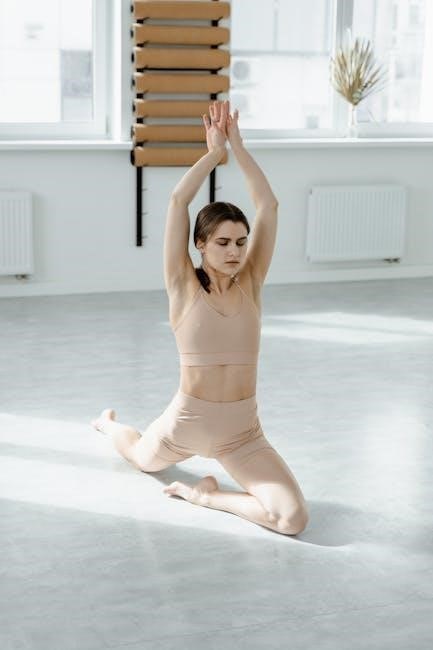
Key Principles of Somatic Yoga
Somatic yoga focuses on internal awareness, gentle movements, and mind-body connection, emphasizing therapeutic release of tension through slow, intentional exercises tailored to honor the body’s natural intelligence․
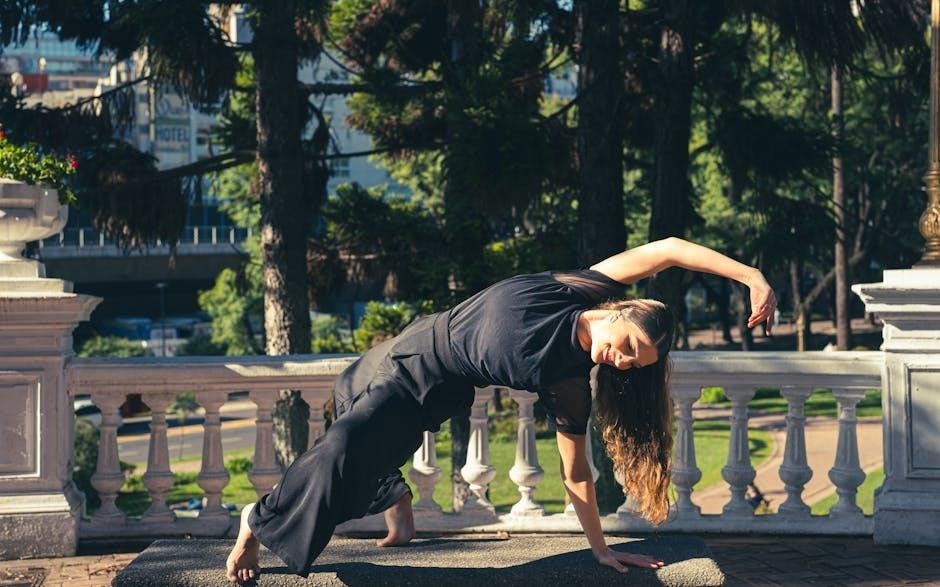
Internal Awareness and Mind-Body Connection
Somatic yoga emphasizes cultivating internal awareness, allowing practitioners to deeply connect with their body’s sensations․ By focusing on how movements feel rather than how they look, individuals can better understand and release physical and emotional tension․ This practice encourages a heightened sense of body intelligence, helping to bridge the gap between mind and body․ Through gentle, intentional movements, participants develop greater self-awareness, which can lead to profound relaxation, reduced stress, and a deeper understanding of their body’s needs․ This mindful approach fosters healing and balance, making it ideal for beginners seeking therapeutic benefits․
The Role of Gentle, Slow Movements
Gentle, slow movements are the cornerstone of somatic yoga, allowing beginners to explore their bodies without strain․ These deliberate actions help re-educate the nervous system, releasing chronic tension and improving flexibility․ By moving slowly, individuals can better sense and respond to their body’s needs, fostering a deeper mind-body connection․ This approach reduces injury risk and enhances relaxation, making it accessible and therapeutic for all levels․ The focus is on quality of movement rather than quantity, ensuring a safe and nurturing practice that promotes healing and overall well-being․
Therapeutic Approach to Yoga Practice
Somatic yoga integrates a therapeutic approach, blending traditional yoga with somatic movement therapy․ This method focuses on healing and self-awareness, addressing physical and emotional discomfort․ By prioritizing internal sensations, it helps retrain the brain to release stored tension and restore natural movement patterns․ This practice is particularly beneficial for those seeking to manage chronic pain, stress, or trauma, offering a safe space for recovery and growth․ The therapeutic nature ensures a compassionate and adaptive practice tailored to individual needs, fostering long-term well-being and resilience․
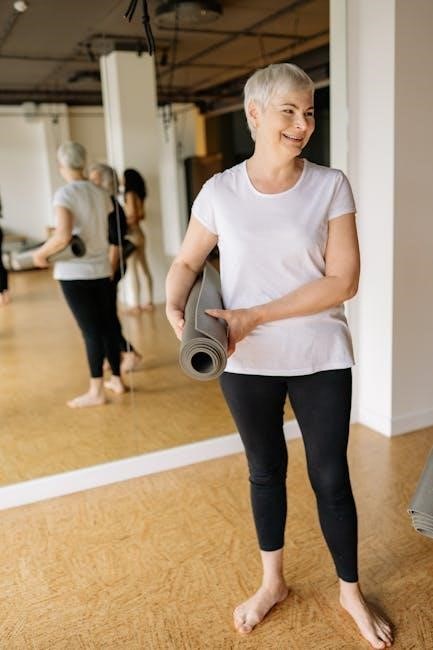
Getting Started with Somatic Yoga
Begin your somatic yoga journey with essential props and a guide․ Focus on gentle movements to heal, reduce stress, and connect deeply with your body․
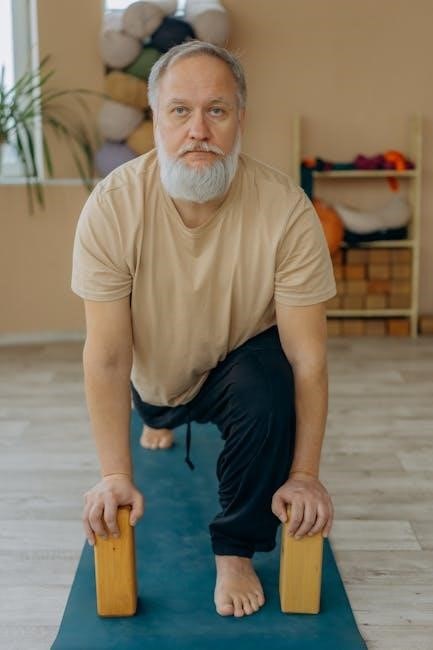
Essential Props for Beginners
For a comfortable somatic yoga practice, essential props include bolsters, blankets, and yoga blocks․ Bolsters support the body in restorative postures, while blankets provide cushioning and warmth․ Blocks help modify poses to suit individual flexibility, ensuring comfort and proper alignment․ These tools enhance the therapeutic benefits of somatic yoga, allowing beginners to focus on releasing tension and deepening their mind-body connection without strain․ Incorporating props fosters a nurturing environment, making the practice accessible and enjoyable for all․
Finding the Right Somatic Yoga PDF Guide
When seeking a somatic yoga PDF guide, look for resources tailored to beginners․ Ensure the guide includes clear instructions, visual aids, and sequences for gentle, therapeutic movements․ Opt for PDFs that emphasize mind-body awareness and emotional release․ Many guides offer step-by-step routines, breathing techniques, and posture modifications․ Choose a reputable source, such as wellness websites or certified instructors, to guarantee quality and safety․ A well-structured PDF will help you establish a consistent practice, fostering relaxation and overall well-being through somatic yoga principles․

The Somatic Yoga Practice
Somatic yoga combines gentle movements with mindful awareness, focusing on releasing tension and promoting relaxation․ It blends traditional yoga with therapeutic techniques, ideal for emotional release and deep calm․
Beginner-Friendly Somatic Yoga Poses
Beginner-friendly somatic yoga poses focus on gentle, accessible movements to release tension and enhance body awareness․ Practices like Seated Forward Bend, Cat-Cow, and Reclined Pigeon encourage relaxation and flexibility without strain․ These poses, often performed seated or lying down, emphasize slow, mindful transitions, making them perfect for those new to yoga․ They promote therapeutic benefits, helping to calm the mind and restore balance, while being adaptable to suit individual needs and comfort levels, ensuring a nurturing experience for all practitioners․
Seated and Lying Down Postures for Comfort
Seated and lying down postures in somatic yoga are designed for maximum comfort and accessibility, especially for beginners․ These poses support relaxation, reduce strain, and promote gentle alignment․ Practices like Supported Seated Forward Bend or Reclined Spinal Twist allow the body to release tension naturally․ Using props like cushions or blankets ensures comfort, making these postures ideal for those seeking a soothing, therapeutic experience․ They foster deep relaxation and mind-body connection, aligning with somatic yoga’s focus on internal awareness and subtle movement․
Gentle Flow Sequences for Full-Body Relaxation
Gentle flow sequences in somatic yoga are designed to promote deep relaxation and ease․ These slow, intentional movements guide the body through a series of poses that release tension and improve circulation․ Perfect for beginners, these sequences are adaptable to all levels, focusing on comfort and breath awareness․ By combining seated, lying, and gentle stretching postures, they create a therapeutic experience that calms the mind and soothes the body․ Using props like bolsters or blankets enhances relaxation, making these flows a nurturing practice for overall well-being․
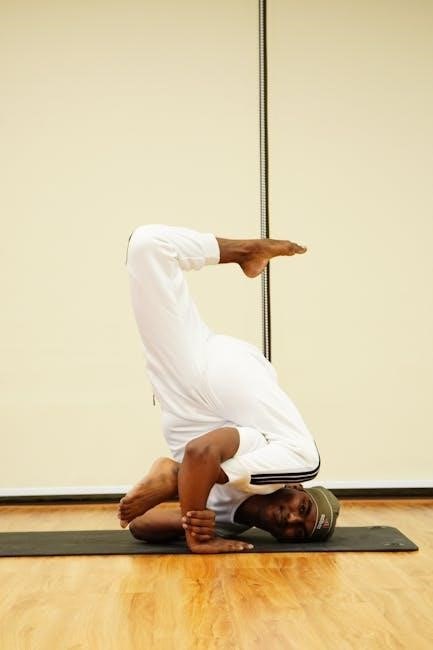
Tips for a Successful Somatic Yoga Journey
Embrace patience, consistency, and self-awareness․ Honor your body’s limits, use props for comfort, and prioritize breath awareness to deepen your practice and foster lasting well-being․
Consistency and Patience in Practice
Consistency is key in somatic yoga, as regular practice helps rewire the brain-body connection․ Begin with short sessions and gradually increase as comfort allows․ Patience is vital; somatic yoga is not about achieving perfection but fostering awareness․ Gentle, repeated movements can lead to profound changes over time, so embrace the journey without rushing․ Celebrate small progress and allow your body the space to heal and adapt naturally․
Listening to Your Body and Honoring Its Limits
Somatic yoga teaches you to deeply listen to your body and honor its unique needs․ This practice encourages you to pay attention to sensations, allowing you to move in ways that feel safe and nurturing․ It’s not about pushing through pain but rather embracing gentle, intuitive movements that promote healing․ By tuning into your body’s signals, you can release tension without strain․ This approach fosters self-awareness and ensures a practice that is both safe and deeply restorative, making it ideal for those seeking mindful, body-centered movement․
The Importance of Breath Awareness
Breath awareness is a cornerstone of somatic yoga, serving as a bridge between movement and relaxation․ By focusing on the breath, you create a calm, grounding rhythm that synchronizes with your body’s natural flow․ This practice helps quiet the nervous system, enhancing your sensitivity to internal sensations․ As you attune to your breath, you deepen the mind-body connection, allowing for more intuitive and therapeutic movements․ Breath awareness not only supports emotional release but also makes the practice accessible, ensuring a safe and transformative experience for all levels of practitioners․
